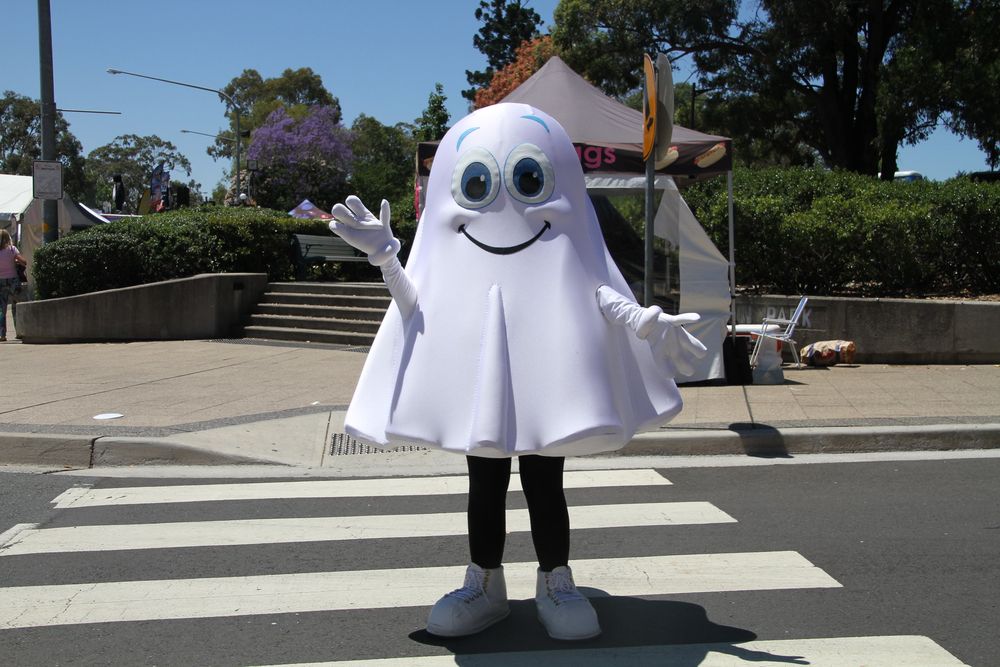Ghost stories have fascinated and captivated people throughout history and across cultures. Despite the passage of time and advancements in science and technology, the allure of the supernatural continues to intrigue and captivate individuals from all walks of life. Some ghost stories have a strong cultural and historical significance. They are often rooted in local folklore, legends, and traditional beliefs, reflecting the values, fears, and customs of a particular community. Sharing and passing down ghost stories from generation to generation helps preserve cultural heritage and creates a sense of collective identity. These tales also serve as cautionary tales, teaching moral lessons and warning against certain behaviors.

A festival attendee dressed up as a ghost at the Festival of Fisher's Ghost. Photo credit: Campbelltown City Council/Wikimedia Commons
One of Australia’s most famous ghost stories from the early 19th century is that of Frederick Fisher.
Frederick Fisher was an English shopkeeper, who became involved in a situation where he either unknowingly or intentionally acquired counterfeit banknotes through his business dealings. Consequently, in 1815, Fred received a 14-year sentence of transportation to Australia. Due to his proficiency in reading and writing, which marked him as an educated individual, Fred was able to redeem himself in Australia, and acquired multiple farms and plots of land. He also ventured into the paper-making industry.
In 1822, Fred Fisher, having completed half his sentence, applied for a ticket-of-leave and permission to purchase some property. Among other properties, Fred Fisher secured a farm at Campbelltown—at the time a remote rural outpost.
In 1825, Fisher had an argument with a local carpenter and was sent to prison. Worried about his farm, Fisher entrusted to his neighbor, George Worrall, the responsibility of looking after the same and also gave him the power of attorney for the duration of time he spent in prison. But when Fisher returned from prison six months later, he found that Worrall had been claiming the farm as his own.
On 17 June 1826 Fisher mysteriously disappeared. George Worrell announced he had sailed for England, and three weeks later he sold Fisher's horse and personal belongings, claiming Fred Fisher had sold them to him before he set sail.
Four months after Fisher’s disappearance a local man named John Farley came forward with a peculiar story. Farley claimed that he had seen the ghost of Fred Fisher sitting on the rail of a nearby bridge. Farley explained that the spectral figure did not utter a word but simply gestured towards a paddock located beyond the creek before vanishing from sight.

Farley’s tale was initially dismissed, but the circumstances surrounding Fisher’s disappearance eventually aroused sufficient suspicion that a police search of the paddock to which the ghost had pointed was undertaken. Surprisingly, the remains of the murdered Fisher were discovered buried by the side of a creek.
Based on circumstantial evidences, George Worrall was arrested and charged with Fred’s murder. Although George initially denied the charge, he later confessed to the crime, and was subsequently hanged. It needs to be mentioned that the story of Fisher’s ghost didn’t play any part in the conviction, as such evidences are inadmissible in court.
Did Farley really see Fisher’s ghost? It has been suggested that Farley invented the ghost tale to conceal the actual source of his knowledge about the whereabouts of Fisher's body. Maybe Farley witnessed the murder and saw the body being buried. He wanted to tell the authorities without implicating himself in the affair. So he invented the ghost story. Another theory is that the actual witness of the murder, in order to protect himself, disguised himself as the ghost and sat on the bridge waiting for a traveler. When Farley passed by, he pretended to be Fisher’s ghost, moaned and pointed to the burial site in the swamp.
Yet another likely theory is that the ghost story was a hoax— a journalist invention by a Sydney-based magazine. Indeed, there are no mention of a ghost in the trial records of the case. The body was discovered, according to the records, not because Fisher’s ghost pointed at it but because the police found several spots of blood on the fence that led them to search the area. The search was assisted by two aboriginal trackers who soon reported traces they thought was “the fat of a white man” (presumably human tissue) floating on the creek. Proceeding on, they came to a spot which had been recently disturbed. Acting on intuition, the spot was dug up and Fisher’s body was discovered.
However the story of Fisher’s ghost came about, it has since entered popular folklore. Now every year, in November, the town of Campbelltown holds the Festival of Fisher's Ghost to commemorate one of Australia's most famous ghosts. The creek beside which the body was discovered was named Fisher's Ghost Creek, although it has now, however, been converted into mostly a storm water drain.
References:
# The Legend of Fred FISHER’s Ghost, The Willis Tree
# In Search of Fisher's Ghost, Skeptical Inquirer












Comments
Post a Comment